Text
Myanmar Sunsets

Rudyard Kipling wrote, “This is Burma. It will be quite unlike any land you know about.” More than a century later, Myanmar retains the ability to surprise and delight even the most world-weary travelers, all in a country where pious Buddhist monks are held in higher esteem than world-famous rock stars.

Myanmar, formerly known as Burma, is a sovereign state in Asia that is bordered by India and…
View On WordPress
#Asia#Bagan#Best Spots#burma#Golden Rock#inle#Irrawaddy River#kipling#Kyaikhtiyo#Mandalay#monasteries#myanmar#Pagoda#Photography#Rangoon#Shwedagon#stupa#Sunset#temples#U Bein Bridge#Yangon
0 notes
Text
Nepal to Tibet Overland Opens At Last
Nepal to Tibet Overland Opens At Last

Gyirong Port, the new Sino-Nepal border, finally reopened to International Tourists on Aug. 30th, 2017.
According to the latest press conference held by the people’s government of Tibet Autonomous Region, starting from August 30th, 2017, international tourists with valid travel documents (that is the Chinese Entry Visa, Group Tourist Visa, and Tibet Tourism Bureau Travel Permit) can enter Tibet…
View On WordPress
#altitude#Asia#border#china#guide#gyirong#hiking#holiday#Nepal#plateau#snow#Tibet#tour#travel#trek#trekking#vacation
0 notes
Text
On the eastern edge of the Tibetan Plateau, nestled between the Dadu River and the Yalong River, sits the highest mountain in Sichuan Province. With its peak at an elevation of 7,556 meters, Mount Gongga has earned the local, Sichuan title of “King of the Mountains”. Also known locally as Minya Konka, the mountain is the highest over 7,000 meters east of the Himalayas, and the third highest peak outside the entire Himalayan Range.
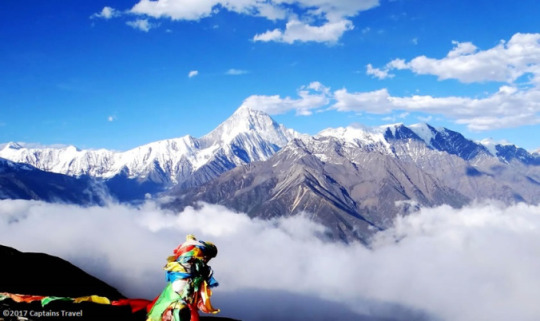
Gongga is Tibetan for “Snow white”, and this mountain has been perfectly named, as it is one of the famous “snow mountains” that can be found in certain parts of Sichuan, Qinghai, and Tibet. Covered in snow all year round, Gongga is a challenging mountain, and one that has only been climbed by 24 people due to its changeable, moist climate. More people have actually died attempting the climb than have actually made it to the summit, with a total of 37 recorded deaths.
While this may sound like a morbid fact about the mountain, it is one that should be well noted for trekkers and climbers in the region. Mount Gongga is one of the most popular destinations in the world for hard-core, international climbers. This middle section of the Hengduan Mountain Range has more than 50 other snow-covered peaks around Gongga, giving an amazing vista of snow-capped mountain scenery that takes your breath away.
Where is Konka Monastery?
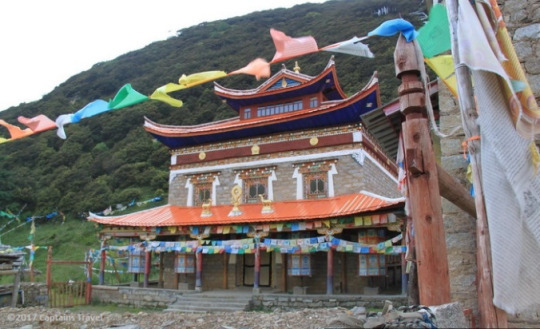
Located on the west side of Minya Konka is a monastery of the Kagyu, or Black Hat, sect of Tibetan Buddhism. Sitting within a narrow valley enclosed by snow-capped mountains, Konka Monastery, while being much like any other Tibetan Monastery, has the advantage of its scenic location, which makes it one of the most popular monasteries in Sichuan Province for tourists. 3,941 meters up the mountain valley, perched above a glacier, this beautifully located lamasery is cut off from the outside world for 3-4 months every year.
A dirt road leads up to the monastery, though you would need a good 4×4 to make the trip. However, the hike up to the monastery is half of the attraction, and it is worth the hours spent walking to see the amazing views of all the surrounding mountains. And the view of the monastery in the valley below as you crest Tsemi Pass is one of outstanding natural beauty.
History of Konka Monastery
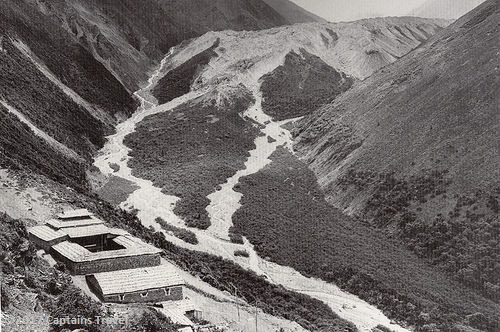
Built in 1285, this beautiful, small temple has quite an interesting history, despite its extremely remote location. More recently, it suffered almost total destruction during the Cultural Revolution, but it has since been rebuilt, and still bears a remarkable resemblance to the original buildings. And more work has been done more recently, with new buildings added, which only add to the beauty of the monastery.
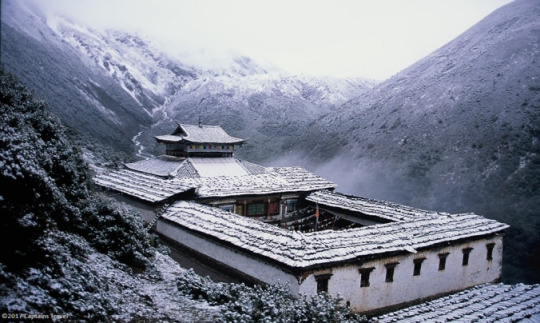
Aside from its 600-year history as a monastery of the Kagyu sect, and almost the “guardian” of the sacred Minya Konka, this was the place where world-famous explorer Joseph Rock almost lost his life while surveying the region for the National geographic. Once known as the “holy mountain of the outlaws”, in the 1920s it was described as “a dangerous and lawless place, infested with bandits; a godless area where even the Buddhist monks pillaged, plundered, and murdered”. There are many accounts of the era, where the infamous Konkalingpas would raid small towns and caravans that ran along the old trade routes.

When Rock wrote his account of the region, he warned against visiting it, as he said “the monks were the most notorious criminals”, who, he alleged, went out on “looting expeditions” between prayer sessions.
While Rock had many tales to tell of the monastery and its notorious “criminal monks”, little is known about its history in the 500 odd years before Rock made it to Mount Gongga. The monastery is known to have been a co-ed monastery that once housed 400 members of the Sangha, and the resident living Buddhas of Konka have all spent their time there. Nowadays, the monastery has only one resident, who keeps it in order, and on special occasions monks come from the lower monasteries such as Liuba, to put on special ceremonies for the multitude of gods that reside in the mountain.
What to See/Experience in Konka Monastery

The formal name for this serene place is Gangkar Namgyel Ling, which when spoken with a Tibetan voice has an innocent, soothing, and almost angelic ring to it. The monastery itself is set in an idyllic spot, surrounded by lush green forests. On a clear day, it is easy to see the massive magnificence of Minya Konka soaring high into the sky, almost directly opposite the monastery. The plants and animals in the area around the monastery grow wild, with no roads cutting through their territory, no machines breaking the peaceful stillness of the landscape, and no hunters. The local people believe that all the natural wildlife in the area around this holy mountain is sacred, and must be kept and preserved.
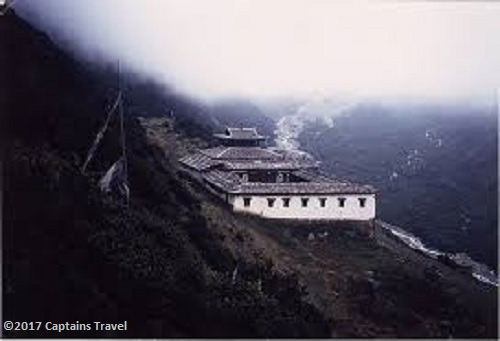
The views around the monastery are the same ones that made Rock so ecstatic about finding the place in 1929. Very little has changed in the almost 90 years since he visited, and as you stand looking out it makes you feel as if you have entered some isolated natural wonderland.

Mount Gongga, across from the monastery, is deemed to be a “holy mountain” by the Tibetan Buddhists that live in the area. They believe that there is no spot on the earth that is more beautiful than Minya Konka, and that one night spent in prayer on the holy mountain is the equivalent to ten years spent sat in prayer and meditation. They say that one offering of burning juniper here is worth hundreds of thousands of prayers, as they believe the mountain is the physical incarnation of the mountain spirit, Dordjelutru.
The Gompa, albeit relatively small, has a very unique chanting hall inside. The walls are completely covered with bright murals of the fierce-looking Buddhist gods, portrayed in many postures but mainly surrounded by skulls and bolts of lightning. There are several small, gold statues of Buddha in niches around the walls, and in the center of the back wall sits a small, solid gold statue of the Buddha Sakyamuni, a replica of the one in the Jokhang Temple, in Lhasa.
In a small back room of the monastery, behind the chanting hall, is one of the most sacred relics of the monastery. Only around a foot wide and three feet high, the relic is an ancient portrait of the mountain god Dordjelutru. Nearby is an inscription in Tibetan that tells how the Indian founder of the Karmapa (red hat) branch of Tibetan Buddhism pronounced the god to be the equal of their prime deity, Shenrezig, and that all the Tibetan Buddhist deities dwelled within the sacred mountain of Minya Konka. It also tells how anyone gazing on the sacred peak would have all his former sins wiped, so that he may begin his life anew.
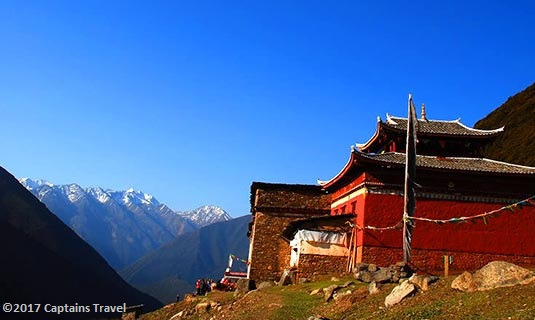
The monastery also contains several rooms that are used as a boarding house for tourists, pilgrims, and the mountaineers who use the monastery as a base camp for climbing Minya Konka. To one side of the rooms is a small chapel room, marked as the place where Joseph Rock spent his one and only night at the monastery. The room contains a golden chorten, or shrine, encrusted with precious jewels. The sarcophagus contains the remnants of a previous “living Buddha” of the monastery, which are now revered as sacred by the monks who visit. Rock spent the whole night in the room with the shrine, and wrote in his journal, “Here, all alone, in the presence of a sacred mummy in a hoary lamasery, I listened to the tempest breaking over the icy peak of Minya Konka. Was this the year 1929 or had time been set back a thousand years?” Entitled “A weird night with a mummy for companion”, Rock’s article tells how he lay in the small cot, shivering as thunder crashed around the mountain, rain lashed at the small monastery, and lightning lit the sky like daytime, as the god, Dordjelutru, “staged an electrical display in this weird canyon”.

Outside, and a little way above the monastery, is the most sacred spot for pilgrims who come to pray there. Almost a thousand meters higher up the mountain, is a small shrine that is dedicated to the mountain god, Dordjelutru. This tiny, red and white shrine is said to be a very special place, where all the prayers could be said direct to the mountain god. While the shrine can be seen as a small red dot on the mountainside, which does not look far, the trek to get there is arduous, and crosses several glaciers and a rough, hard climb up the glacial moraine valley.
Wreathed in shifting clouds, life within this small monastery goes on at its own, steady pace, as the lone, resident lama observes the ancient Buddhist traditions, undisturbed by the few visitors from nearby villages and even other countries. For those pilgrims who are devout, the kora around the mountain is one that is one that is said to give huge merit to those who complete it. It is not normally a popular thing for pilgrims to do the kora around Minya Konka for most of the year. However, at the time of the Saga Dawa Festival, hundreds of locals from the surrounding villages would be in the mountains for the circumambulation.

Hiking Routes to Konka Monastery
Minya Konka is a huge area, and there are several good trekking routes that you can use to get to the monastery. Or you can try out your own route based on the routes available, to give you the itinerary that takes you to all the places you want to visit. However, there are three main routes that are the most popular, which you can take as recommended routes to Konka Monastery.
The first route takes around five days, and takes you from Kangding on a drive to Shangmuju Village, from where you will start the trek. From Shangmuju, you will trek to Zimei Pass, and then the Upper Zimei Village on the first day, where you will camp for the night. The following day the trek takes you to Konka Monastery, and give s the best local view of Minya Konka. After staying in the temple boarding house for the night, the trek then continues to Lower Zimei Village, and on to Bawang lake. At the lake you will camp for the night, and then set off next morning to Jiebei Stone, from where you will get the car to Caoke, then on to Shimian, and back to Chengdu the following day.
The second route starts in Kangding, where you will be driven to Laoyulin, where you can hire a horse and guide, before trekking up to the Gexi Pasture, where you will camp for the night. The following day is a trek to the Liangchi River, where you will take the route towards the Riwuqie Pass, via Shangriwuqie. The route passes the Tianhaizi Mountain, with its impressive views. After camping the night at Shangriwuqie, the morning sees you trekking to the Riwuqie Pass, and enjoying the snow mountains and glaciers that can be seen along the way. Cresting the pass, you will then head down into the Moxi Valley, where you will stop for the night. The following morning, you trek the last stretch to the Konka Monastery across the Winter Pasture. The Temple and Konka is a famous religious shrine, and a great place to get the best shots of Minya Konka. The final night is spent in the temple, and in the morning your trek heads down to Shangmuju Village, and then the drive back to Kangding.
This final route of the three is the longer one, taking at least six days to complete. Heading from Kangding to Laoyulin by car, you can hire the horse and guide for the trek there, before starting off for Gexi Pasture. After crossing the pasture, you will arrive at Liangchi River, where you will camp for the night. The morning takes you up to Riwuqie, stopping at Shangriwuqie for the night. Once across the Riwuqie Pass the next morning, you will trek down to the campsite in Moxi valley, passing some of the most beautiful scenery on the way. Camping at the far end of Moxi Valley, you start the following morning with a light trek across the Winter Pasture to the Gongga Temple. As the altitude descend the whole way, it makes it a little easier than the climb up to the pass. After a short stop at Gongga Temple, you continue to Upper Zimei Village for the night in a local Tibetan house. From Upper Zimei Village, you will travel the day by car to Zimei Pass, where you can take photos of the spectacular view. After, you will descend to Lower Zimei Village, where you will stay in a local Tibetan house for the night. The last day of trekking takes you to Bawang Lake, or you can choose to take the car, if you are too tired. After a short trek through the woods around the lake, you will reach Jiebei Stone, and take the car to Caoke for the end of the trek.

Konka Monastery – The Highlight of Mount Gongga On the eastern edge of the Tibetan Plateau, nestled between the Dadu River and the Yalong River, sits the highest mountain in Sichuan Province.
0 notes
Text
Since the world saw Angelina Jolie swinging through the ruined temples of Cambodia as Lara Croft, the country has been crawling with tourists eager to get a better look at the places made famous by the film. In recent years, Siem Reap, a town that is close to a huge complex of ancient Buddhist and Hindu temples, is now a major tourist destination, with more than 120 hotels, from basic hostel to Ultra-DeLuxe. While there may be small pockets of opulence such as this, the majority of the country is still poor, and visitors to Cambodia should get out to see the reality of this beautiful country.
After several decades of civil war, and the genocide brought about by Pol Pot and the Khmer Rouge, Cambodia’s modern, violent history is fresh in the minds of the world. However, with the introduction of a new regime of democracy, the nation sits on the verge of a new revolution – as a popular travel destination. And this is mainly due to the jungle-covered ruins of Angkor Wat, and other places just like it. The ancient capital of the old Khmer Empire is also the world’s largest, single religious monument, and is one of only a handful of temples that have been uncovered in the dense jungle landscape. Hundreds of other beautiful, ancient temples and pagodas exist, buried under the growth of tropical jungle, and sometimes used as backdrops for major Hollywood blockbusters.
Over the years I have found myself in Cambodia on several occasions, both as soldier and tourist. The first time I went there was with the military as part of the UN resolution on foreign aid, to protect UN aid workers who were helping to get the country back on its feet. Unfortunately, I spent more time watching the jungle for former Khmer Rouge activists than watching the famous sites I have mentioned here, although in Phnom Penh I got to spend time around the city and explore a little. Thankfully, the horrors of the past are long gone, and the Khmer Rouge we encountered there no longer cause trouble. Cambodia has come a long way since the days of Pol Pot and the Khmer Rouge, and although it is not perfect, it’s a lot safer for tourists now.
From the ruins of Angkor Wat to the Killing Fields of Choeung Ek, you can really immerse yourself in the rich, yet violent history of Cambodia. Whether you are following in the footsteps of adventurers, or enjoying freshly baked bread in one of the delightful cafes of Siem Reap, it is almost impossible not to be affected by the stories of Cambodia. Tales of glory and of ruin, tragedy and joy, all are etched into the deathly silence of the stones, and shines from the friendly faces of the Khmer people. Wherever you travel in this once-devastated land, Cambodia is a country that leaves an unforgettable, indelible impression.
Top Spots for Tourists in Cambodia

Sunrise at Angkor Wat
In Siem Reap, lies the ancient temple of Angkor Wat. Probably the most famous of all places in the country, people show up in their thousands to watch the sunrise at 5:30am. While many people crowd the walkways, jostling for the best shot, if you get off the main walkway and sit on the steps of the outpost buildings, you are almost guaranteed a better view, with less people. Built over the course of more than thirty years, Angkor Wat was the 12th century home of King Suryavarman II after he died.
Completely buried by jungle until it was discovered by French colonists in the 1800’s, what they uncovered is now considered as one of the Wonders of the World. The well-preserved temple has numerous bas-relief walls that depict the many levels of heaven and hell, some of which are quite gruesome, as well as more than 1,800 seductive Dancing Maidens carvings. The temple is surrounded by a huge rectangular lake, and rises up on three terraces to the central shrine and tower. The temple reflects the traditional Khmer design of the “temple mountain” which is a representation of Mount Meru, the home of the gods in Hinduism.

Angkor Thom
Locally mispronounced as “Uncle Tom”, this temple has not been restored in the way Angkor Wat has, though it has several interesting features. The main feature of the temple is the entrance bridge, which is flanked by 54 stone-carved warriors who appear to be playing a tug-of-war game with the sacred Naga Snake. Many of the warriors’ heads are missing, stolen by looters after the war in Vietnam, some of which have been recovered and are now in museums across the U.S. The bas-reliefs here are mainly of people playing chess, cooking, and having babies, and one even depicts two monkeys performing sexual acts, known locally as the “Monkey 69”.

Ta Prohm
The temple that was used in the Tomb Raider film, this ancient place was left completely undisturbed by restoration teams, and is still full of crumbling walls intertwined with thick tree roots. It was left as it was found, to allow tourists to see the state in which many of the temples in the area were discovered.

Artisan’s Angkor
Artisan’s Angkor is a trade school for disadvantaged Cambodians in Siem Reap, where the students make all kinds of local handicrafts, which fly off the shelves of the colorful school store as fast as they can make them. The school makes everything from silver-plated ornamental boxes to vividly colored scarves made of local silk, and it is all of high quality.
Downtown Siem Reap
Take a Tuk-Tuk to Downtown Siem Reap; This nimble mode of transportation – essentially a 4 person carriage pulled by motorcycle – congests every alley, lane and road in Siem Reap. It takes just a few minutes (and about $2) to get to…..

Pub Street and Siem Reap Night Market
This area of Downtown Siem Reap has a nighttime vibe that is comparable to that of New Orleans at Mardi Gras. There are dozens of restaurants selling all kinds of food, both local and foreign, and spas where you can relax, get a massage, or try the traditional Cambodian J’Pong heat and herbal treatment. Most of the spas have pools inside where you can get a “fish pedicure”, which can be a little ticklish as the small fish eat the dead skin on your feet. The night market is full of deals on items you can find in many such markets across Asia, but a little searching can be rewarded with some excellent finds.
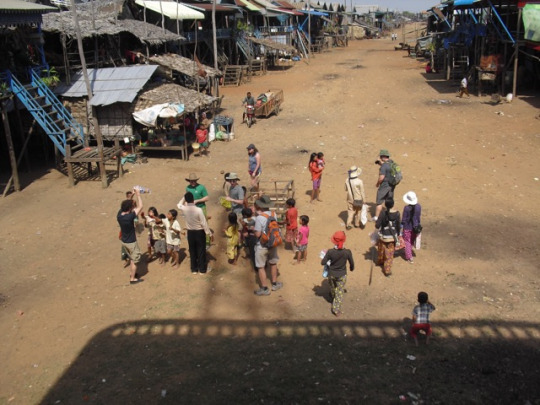
Tonlé Sap
Tonlé Sap is the largest freshwater lake in Cambodia and South East Asia, and is of major importance to the country. The lake is subject to the changes of the seasons, and shrinks or expands depending on the monsoon rains. Dry season in Cambodia is from November to May, and the lake drains into the Mekong River at Phnom Penh. In the monsoon season, the lake changes direction, and fills with water to make an enormous lake that is the home to numerous Vietnamese and Cham communities that live in floating villages around the lake.

Preah Vihear
Preah Vihear is a striking Khmer temple, dramatically set on a 1,722-foot cliff in the Dângrêk Mountains. The views from the top expand over lowland Cambodia, with the peak of Phnom Kulen watching silently in the distance. Spread over more than 2,000 feet, the temple’s five Gopuras are comprised of four levels and four courtyards, all of which are decorated with intricate carvings. Constructed mainly between the 11th and 12th centuries, the temple was dedicated to the Hindu god Shiva. Set on the border between Cambodia and Thailand, ongoing territorial disputes between the two countries have closed access to the temple from the Thai entrance.

Banteay Srei
Although officially part of the Angkor complex, Banteay Srei lies 25 km (15 miles) north-east of the main group of temples, and therefore often considered a separate Cambodia attraction. The temple was completed in 967 AD and is built largely of red sandstone, a medium that lends itself to the elaborate decorative wall carvings which are still clearly visible today. Banteay Srei is the only major temple at Angkor not built for a king, instead it was constructed by one of king Rajendravarman’s counselors, Yajnyavahara.
Mondulkiri
Mondulkiri is a wild, sparsely populated area of Cambodia, dotted with rolling hills, jungles, waterfalls, and valleys. The region is home to some of the country’s most rare and endangered wildlife, including leopards, water buffalo, and elephants. Almost half of Mondulkiri’s population belongs to the Bunong minority group, who hunt for most of their food. It’s a fantastic region for visiting traditional villages and interacting with elephants in their natural habitat. The cool climate, stunning scenery and wildlife-viewing opportunities make it a perfect area for trekking and hiking.

Popokvil Waterfall
Set in Bokor National Park, Popokvil Waterfall is a stunning two-tiered waterfall, which looks particularly gorgeous during the rainy season. Although the appearance of the surrounding rainforest has been somewhat marred by the construction of a huge casino on the hill summit, the area is still quite pretty. The waterfall takes its name from an expression meaning ‘swirling clouds’, perhaps due to the ever-present mist that surrounds it. It’s a great place to stop for a refreshing swim and, if you’re lucky, catch a glimpse of the endangered animals that live in the area, such as the pig-tailed macaque and the Malayan sun bear.
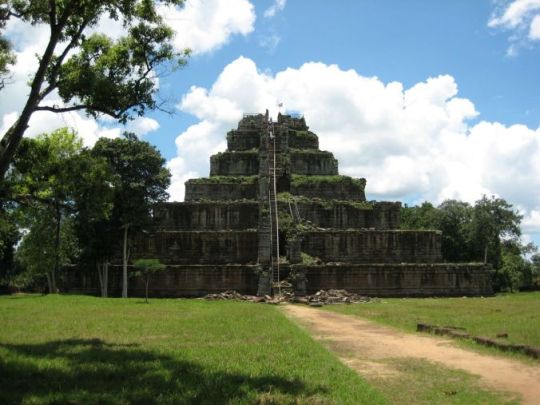
Koh Ker
Formerly the capital of the Khmer Empire from 928 to 944 AD, the site has some spectacular buildings and immense sculptures, and is dominated by the 30-meter-tall temple mountain of Prasat Thom. Rising high above the surrounding jungle, the temple is topped by a giant Garuda (a mythical half-man, half-bird creature). Abandoned and left to the jungle for almost a thousand years, the temple can be likened more to ancient Mayan ruins than typical Khmer architecture, and the encroachment of the jungle and its wildlife on Koh Ker only adds to the site’s sense of mystery.

Drive Route 6 to Phnom Penh
The largest city in Cambodia, Phnom Penh has been the country’s capital since the French colonial era. Once called the “Pearl of Asia”, it is considered to be one of the prettiest cities in Indo-China, though it is still recovering from wars and revolutions. Sitting on the Mekong River, the city dates back to the 15th century, and the French influence can still be seen in the architecture of the city. From the glittering Royal Palace and crowded night markets to the sophisticated restaurants and bars, Phnom Penh’s beauty is complex, and realized slowly by visitors as they tour the city.
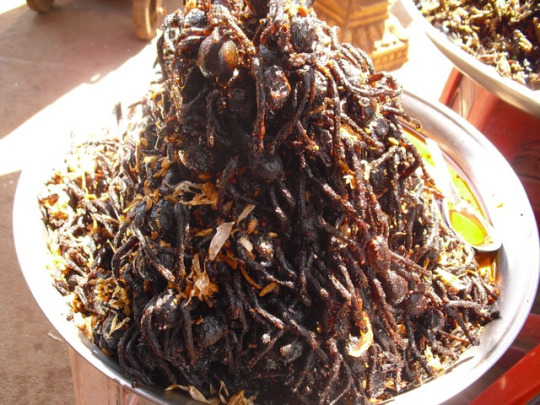
Eat A Spider (or watch someone else do it)
There’s a stop along Route 6 Cambodia that features platters of fried tarantulas, crickets and birds. There are also bananas and mangos for the non insect eater. Believe it or not, spiders actually taste nice. If you have ever eaten crickets or deep fried locusts (I remember when that was a phase in the north of England in the late ’80s), then it is not much different. Trying new foods is all part of the charm of a new country. Just go for it!

Killing Fields and Tuol Sleng Genocide Museum
15 kilometers from Phnom Penh, the Killing Fields is a monument like no other in the world. The monument is filled with bones and skulls from one of the hundreds of killing fields across the country. The Cambodian government decided to leave majority of these mass graves alone and undisturbed, making this one both a monumental cemetery and a hallowed ground.

Nearby is the Tuol Sleng Genocide Museum, which was once a peaceful high school and now is a memorial to those who died there. Between 1975 and 1979, the school became a torture and interrogation center for the Khmer Rouge, from which very few survived. Doctors, professors, clergymen, and other high-value professionals were rounded up and chained, electrocuted, dismembered, or beaten to death at the order of Cambodian dictator, Pol Pot. Those who survived the torture were taken out to the Killing Fields, and executed. While it is a hard place to visit, like many other Holocaust Museums, it is there to remind people of the horrors of dictatorship, and make sure it can never happen again.
You can probably put together a whole trip based on this list, although if you travel to Cambodia to do all of these, it may take you several weeks. Go there, and enjoy this beautiful land as it recovers from the decades of war and hardship. For pretty soon, it will be as popular and tourist-oriented as places like Thailand, Bali, and Boracay!
The Most Memorable Attractions In Cambodia Since the world saw Angelina Jolie swinging through the ruined temples of Cambodia as Lara Croft, the country has been crawling with tourists eager to get a better look at the places made famous by the film.
0 notes
Text
Change your Mindset and Believe you can Travel
Change your Mindset and Believe you can Travel
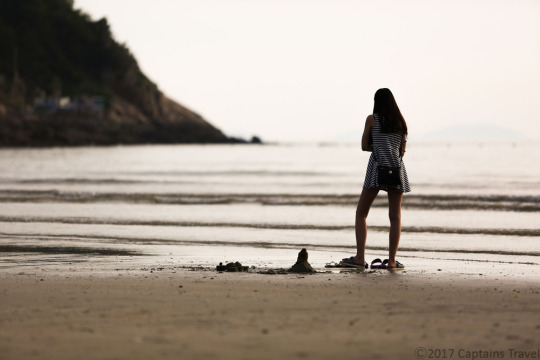
“Your advice is great if you are middle-class, your parents are giving you money, or you’re from the West. Your ideas can never work for me. I’m too poor to travel. This advice is only for privileged people.” I encounter this line of thought frequently, and after two recently published articles on Canadian travel site Drifter Magazine, I’ve heard it even more lately. Every travel naysayer…
View On WordPress
0 notes
Text
Wherever you go around the world, you’re most likely to use public transport at some point. Once you get to the airport, taxis are normally the best option, especially if you have lots of heavy luggage. However, in most countries around the world – in my experience after 30 years of travelling – public transport is sorely lacking.
Here in the Philippines, it’s a very different story. I’ve travelled to every continent, and covered 132 countries, both as a tourist and a soldier, but in all of that time, there has never been a “public” transport system to match that in the Philippines. That’s not to say it is the same all over the country. There are many remote regions where public transport is not as good, such as remote areas of the provinces where people live miles apart, and riding your carabao (the Philippine domestic water buffalo) is still considered the fastest way to get around.
However, in the area where I live, in the Province of Laguna, public transport is unbelievable. Moreover, it is like that in almost every part of the country where there is a decent population. Everywhere I go around the world, I like to try out the public transport systems. From the rickshaws in India and Thailand (here we call them pedicabs or traysikels) to the dolmuşes of Turkey (a kind of minibus on a set route), I’ve tried them all. However, in none of the countries I have visited could you travel from door to door, on a motorized public transport vehicle, without walking more than a few yards. Here you can, and I will explain how later.
I use public transport here all the time, whether it is a journey north to Ilocos Sur, or a quick trip to bayan (town centre – pronounced buy-an) to get some groceries. After I first came here, I soon discovered that Filipinos drive like no-one else on the planet – with a complete disregard for any other road user, and an “I have the right of way” attitude that makes me want to blow up their car, with them in it! I had a few near misses in the first couple of years, driving the car, my motorbike, and my father-in-law’s traysikel, and finally decided that I was going to give up driving. Road rules are completely ignored, and it is not uncommon to have traffic driving contraflow and blocking the road for oncoming traffic, which they then blame for slowing them down. Safety first – let someone else drive!
Local Transport
So, let’s look at the forms of local transport we have here in the Philippines, and how each one works, both on its own and in conjunction with the other types of public transport.
Taxi
Metered taxis are common in Manila and most major provincial hubs. Flagdown fare starts at around P40, and a 15-minute trip rarely costs more than P150. Airport taxi fares usually start at a minimum of P70, then a per-kilometre charge.

Most taxi drivers will turn on the meter; if they don’t, politely request that they do. If the meter is “broken” or your taxi driver says the fare is “up to you”, the best strategy is to get out and find another cab (or offer a lower price). Rigged meters are also becoming more common, although it must be said that most taxi drivers are honest.
Though it’s not common, there have been cases of taxi passengers being robbed at gun or knife point, sometimes with the driver in cahoots with the culprits or the driver himself holding up the passengers. Get out of a cab straight away (in a secure populated area, of course, not in the middle of nowhere or in a slum area) if you suspect you’re being taken for a ride in more ways than one.
An alternative is to arrange a car and driver for the day – from P2000 to P4000 – through your hotel or another trustworthy source.
Uber
The Uber system of getting a car through an app on your smartphone has had major problems in the Philippines, as the whole concept of using a private vehicle for paying passengers is illegal. The Land Transportation Franchising and Regulatory Board (LTFRB) has put a hold on new drivers, and wants Uber to disassociate themselves from drivers without proper documents.

Meanwhile, the Land Transportation Office (LTO) regulations state that in order to carry paying passengers, vehicles must have a commercial license plate, and carry insurance as well as the driver having a professional driving license. Uber drivers being able to continue in the Philippines is as yet uncertain. The costs are not that low either.
Light Rail/Manila Rail
Some parts of Manila are served by an elevated railway system, akin to rapid transit metro. Known locally as LRT-1 (the Green Line that runs north-south) and LRT-2 (the Blue Line that runs east-west), and MRT-3 (the Yellow Line, which runs along the north and south lanes of Epifanio de los Santos Avenue, known locally as EDSA), these three railway lines transport more than 1.25 million passengers a day.
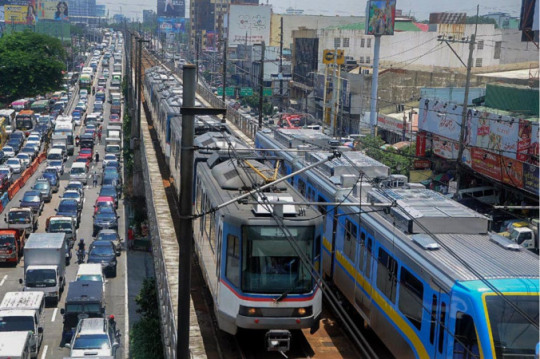
The major benefit of the LRT and MRT lines is the speed at which you can get from one part of Metro Manila to another. With Metro Manila comprising of 16 cities and the municipality of Pateros, this huge metropolis, known collectively as National Capital Region, covers an area of 619.5 km2. To complete the journey along EDSA by bus or car, from south to north, would normally take 4-5 hours, due to the immense volume of traffic.
The main drawback of the LRT and MRT lines is the crowded carriages. No matter what station you get on, chances are you will be standing the entire trip, and crushed up together with hundreds of other commuters.
Jeepney
The first jeepneys were modified army jeeps left behind by the Americans after WWII. They have been customised with Filipino touches such as chrome horses, banks of coloured headlights, radio antennae, paintings of the Virgin Mary and neon-coloured scenes from action comic books, as well as national flags and scenes from different countries, depending on the work location of the Overseas Filipino Worker (OFW) that paid for the jeepney.
Jeepneys form the main urban transport in most cities and complement the bus services between regional centres. The starting fare is usually P8, rising modestly for trips outside the primary distance allowed for that P8 fare. Routes are clearly written on the side of the jeepney, and signs in the windscreen show what locations the jeepney will pass through.
Jeepneys have a certain quirky, cultural appeal, but from a tourist’s perspective, they have one humongous flaw: you can barely see anything through the narrow open slats that pass as windows. The best seats are up front next to the driver.
Again, in most places, jeepneys can fill up fast, especially during rush hours, and sitting cramped with 10 other people on each side of the jeepney is normal. Drivers try to cram as many people in as possible, to get the maximum possible fare, and some passengers are even hanging on to the back, while standing on the step or the rear fender, although this is technically illegal. In more remote areas, it is common for jeepneys to have a roof full of passengers.
I have to say it, jeepneys are one of my favourite forms of public transport here, and I love to commute around the country. Although I can drive, I don’t like to here, and it’s much nicer to let someone else worry about the traffic while we watch the world go by through the small “windows”.
Traysikel
Found in most cities and towns, the traysikel (pronounced try-see-kell) is the Philippine rickshaw – a little, roofed sidecar bolted to a motorcycle. The standard fare for local trips in most provincial towns is P8, which goes up piso by piso the further you get from the pickup point. Traysikels that wait around in front of malls, restaurants and hotels will attempt to charge five to ten times that for a “special” trip, which is like hiring the whole vehicle. Avoid these by standing roadside and flagging down a passing P8 tricycle.
The general rule is, if you flag down a passing traysikel it is single fare only. And they will normally slow down to ask where you are going as they go past. If they don’t, it usually means they are going home or are probably not for hire. Travelling on a traysikel can also be done from a terminal. Just like buses and jeepneys, traysikels have terminals (or should if they are franchised, although some “colorum” traysikels just roam around without the correct plates or licenses picking up passengers along the way). A trip from the terminal, unless you ask for the “special” trip, will cost a single fare.
For example, if I get a traysikel from bayan to the house, it’s P13 if it’s shared. The “special” costs me P52, the price of four normal passengers. Prices can vary from terminal to terminal, so it’s best to always ask the fare before you ride. Traysikels are my other favourite form of public transport here, and the drivers work hard to make enough to feed their families, but they will rarely try and rip you off, even as foreign visitors. If the single fare in your shared traysikel is P8, that’s what you’ll pay.
You can also charter tricycles for about P300 per hour or P150 per 10km if you’re heading out of town.
Pedicabs
Many towns also have non-motorised push tricycles, alternately known as Pedicabs or padyak, for shorter trips. Padyak is a the Tagalog word for stomping or forcefully stepping, which is the action used by the drivers when they are pedaling a pedicab with passengers.
Fares are really cheap, sometimes as much as a few pesos less that traysikels, but they will only go short distances. Many open subdivisions (our kind of housing estate) have Pedicabs at the entrance, as well as dotted around inside, for resident’s convenience.
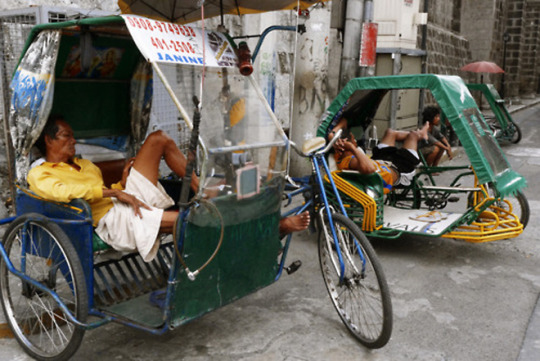
Habal-habal
In the mountain barangays or in the countryside where roads are steep and unpaved, Filipinos always find ways to make things faster and easier to navigate. So, motorcycles are turned into motor-taxis to replace carabaos as a mode of transport.
The normal motorcycle or motorbike is enough only for a passenger and a driver. However, the “habal-habal” motorcycle can carry 2 to 8 passengers (if installed with wooden wings). They are most common in the Visayas and northern Mindanao, although the motorcycle taxi is making inroads in Metro Manila in recent years, just taking only one passenger at a time.
ONLY IN MINDANAO. A motorcycle with 6 passengers ply the Pagalungan highway in Maguindanao province on June 8, 2012 MindaNews photo by Ruby Thursday More
In some areas in the Visayas and Mindanao, “habal-habal” is the term used to call a motorcycle-taxi where the driver and the passengers are in “habal” (animal) position. “Habal” is a Bisayan term that literally means “the sexual (act) intercourse of animals” but now, it seems like the meaning has evolved to mean the mode of transportation… probably due to the “intimate” way passengers are crammed together behind the driver.

Kalesa
A kalesa (also known as caritela or karitela) is a horse-drawn calash used in the Philippines. It was one mode of transportation introduced to the islands in the 18th century by the Spanish, and was initially reserved for only nobles and high-ranking civic officials. These are rarely used in the streets today, except in the tourist-frequented areas of old cities and some rural areas.
A kalesa looks like an inclined cart, and is drawn by a single horse. It has two round wheels on each side and two rows of seats that can accommodate four persons. The driver sits on a block of wood located at the front of the cart near the horse.
Although the kalesa has become a rarity, century-old examples are still preserved in areas of the Philippines, such as in Vigan and Laoag. Kalesas can also be found in Intramuros, where they cater to tourists and Binondo in Manila, as well as in Iligan, where decorated kalesas can be taken for a ride along a specific street. In Cagayan, kalesas are common, especially in Tuao and other municipalities of the province. In Tuguegarao, the carriages are a part of the traffic along with private cars, motorcycles, tricycles, jeepneys, trucks, and bicycles.
Bus & Van
Philippine buses come in all shapes and sizes. Bus depots are dotted throughout towns and the countryside, and most buses will stop if you wave them down. Bus “terminals” also run the gamut. Some are well-secured large garage-like structures with destinations clearly signposted and even ticket booths, whereas others are nothing more than a few run-down outdoor sheds with drivers clamouring for your business. I have even known some locally that are “terminals” in the car park of the local Jollibee or SM Mall.
More services run in the morning – buses on unsealed roads may only run in the morning, especially in remote areas. Night services, including deluxe 27-seaters, are common between Manila and major provincial hubs in Luzon, and in Mindanao.
In NCR, there are normally two kinds of buses. The air-conditioned buses, with closed windows and cool, have their refreshing AC running at close to freezing all the time, while the “ordinary” buses are open, old and amazingly fast. Whereas the AC buses run along the highways almost following the road rules, the “ordinary” buses, which have no air-con except the open windows and rust holes, race along at breathtaking speeds, changing lanes at the drop of a hat, and not slowing down for anyone or anything smaller than them.
While it is nice to ride the AC buses in the hotter weather here, the “ordinary” buses have more character, are cheaper, and often get you there faster, unless it is rush hour in Manila. They look and sound as if they are about to fall apart, but I’ve not ridden on one that has… yet! And when they are going at speed, the open windows give you a cooling breeze, even if it is smog-filled from traffic fumes.
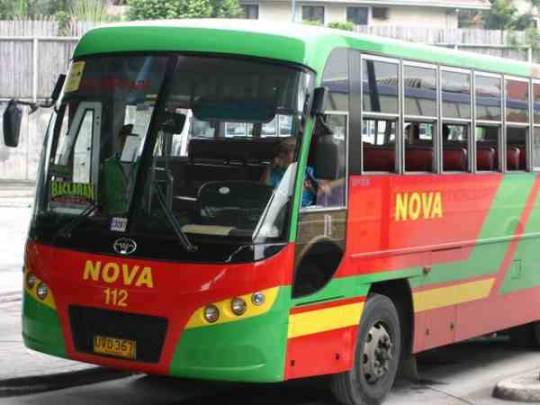
When riding the buses in Manila, especially the “ordinary” ones, be aware of the fares from place to place. It pays to listen to where the people around you are going, to know how much the ride will be, as the conductors will often add a little “surcharge” to foreigners who don’t know the fares. In more than a year of daily trips from Laguna to Makati, I was often told the fare was P10 more than it actually was.
Air-con minivans shadow bus routes in many parts of the Philippines (especially NCR, Bicol, Leyte, Cebu, Palawan and Mindanao) and in some cases have replaced buses altogether. However, you may have to play a waiting game until the vehicles are full. While they are a lot faster, they are not allowed to stop anywhere in Metro Manila, unlike the jeepneys, and there are many that are run illegally, with private use plates instead of commercial plates.
Door-to-door Service
As I mentioned earlier, the Philippines is the only place I know where you can go door-to-door without walking more than a few yards. And I said I would explain how, so here it is.
The best example is going from my house, inside a subdivision, to my wife’s tita (aunt) who lives in Parañaque, Metro Manila.
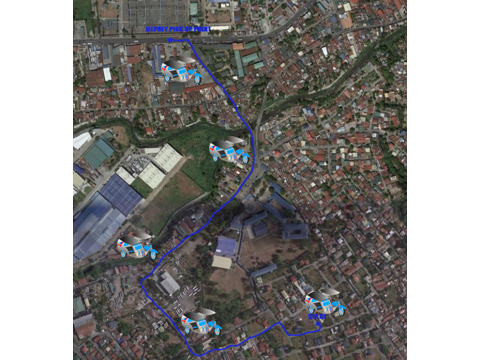
From my house, I can get a traysikel just outside the house to the main highway. Since I live inside a subdivision, a little village of sorts inside the city limits, traysikels often drop passengers off inside, and then go back out. Since they are often not part of the TODA (Traysikel Operators and Drivers Association) for that subdivision or barangay, they cannot go to the nearest terminal, and will pick up roadside passengers along the way, to maximize their income for the trip.
From where I get dropped on the highway, I can get a jeepney across the road to take me to Alabang, in Muntinlupa, which drops off inside Starmall.

The terminal for the buses going all over NCR is right outside, and I can get on one that says “Ayala Ibabaw” on the signs in the windscreen. Conductors are always touting for passengers, and will help with which bus you need to take for people who are not sure.
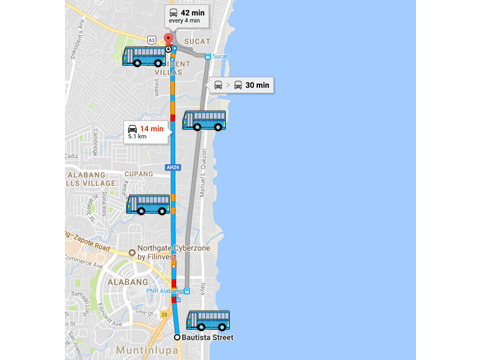
The bus route takes me all the way to Parañaque along SLEX (South Luzon Expressway) and Metro Manila Skyway, and drops off at the Sucat exit.

Cross the road, and I get a jeepney going to San Isidro, which is a single fare price of P8. Get down from the jeepney at the BPI Bank at Greenheights Ave, and cross the road, to the compound where my wife’s tita lives.
The return journey is much the same. A jeepney going past the road outside the compound will take me back down to the Sucat exit, where I can jump on the first bus back to San Pedro, Laguna. Both AC and “ordinary” buses run the route, and there are hundreds of them going that way looking for passengers. (Alternatively, I can get the bus back to Starmall, and do the journey exactly backwards, but I prefer to get a bus all the way to San Pedro.)
At San Pedro, a jeepney passing by can take me into bayan, and drops off around 20 yards from the traysikel terminal for my subdivision. Another P8 fare for this part of the trip.
From the terminal in bayan, the traysikel takes me back to the subdivision, as a shared ride for only P13, and I can direct the driver on which turns to take to get to my house, though since most of them know me from the terminal, I often don’t need to direct them.
What about the other passengers in the traysikel? Well, it’s the norm here for traysikels to carry rideshare passengers (see, we had rideshare and pool vehicles years before Uber!), and there is a courtesy to let the closest one out first, even if it means travelling through many streets to get to your own house after dropping them off.
Another thing that we have with the traysikels is service. Traysikel drivers are some of the nicest people you can meet here, and will gladly carry your shopping bags and sacks of rice to your door, and even inside (if you don’t have nasty, biting dogs like I have), for no extra charge.

So, if you are thinking of coming to the Philippines, try to travel on the local public transport, and experience commuting the Filipino way. It really is “More Fun in the Philippines”.
Travel in the Philippines – Commuting like a Local Wherever you go around the world, you’re most likely to use public transport at some point. Once you get to the airport, taxis are normally the best option, especially if you have lots of heavy luggage.
#bus#calash#caritela#dolmus#door-to-door#habalhabal#jeep#jeepney#kalesa#karitela#LRT#MRT#ordinary#padyak#pedicab#Philippines#rail#taxi#travel#traysikel#tricycle#uber#UVExpress#van
0 notes
Text
Walking on air is something that previously only gods could do. Or Criss Angel! Now you can too, with the glass bridges and platforms at some of China’s most famous – and highest – tourist attractions.
Mount Langya Glass Platform
China seems to be intent on giving its tourists a severe case of vertigo. The country has built yet another glass bridge, this time suspended 1,476 ft above a rocky gorge on Mount Langya in the Hebei province. Visitors can walk several hundred feet along the 5,015 sq ft see-through walkway, which ends in a large viewing platform.
The observation deck is large enough to hold 200 people at a time, and tourists who manage to look down will be greeted with a bird’s eye view of one of China’s most beautiful national forest conservation areas. They will also be able to catch a glimpse of a cave halfway up Mount Langya that is full of stalactites and stalagmites.
The bridge is one in a long line of towering see-through structures being built in China.
Zhangjiajie Grand Canyon Glass Bridge
The world’s longest and highest glass bridge, Zhangjiajie Grand Canyon Glass Bridge opened to the public on August 20, 2016. It offers a way to enjoy a panoramic view of the stunning Zhangjiajie Grand Canyon — if you dare to walk on it!
The glass bridge will not only serve as a walkway. Visitors can go bungee jumping and zip-lining off of it as well.
Length: 430 meters (1410 feet)
Width: 6 meters (20 feet)
Height: 300 meters (984 feet)
Highlights: bungee jump and beautiful natural views of towering sandstone pillars
And that is not the only glass attraction in Zhangjiajie. There are three glass skywalks in Tianmen Mountain Scenic Area, about 85 kilometers away from Zhangjiajie Grand Canyon Glass Bridge. The glass skywalks cling to the vertical cliffs at a height of over 1,400 meters (4,700 feet).
Glass Walkways on Tianmen Mountain, Zhangjiajie, China
It is certainly not a path for the faint-hearted. On one side a sheer rock face, on the other a 4,700 ft drop – and all to separate the brave traveler from a deadly plunge is a 3ft-wide, 2.5in thick walkway. And if that is not enough to bring terror into the pit of your stomach, the path running alongside a Chinese mountainside is made out of glass, allowing a crystal-clear view of where one false step can take you. So it was perhaps understandable that one woman tackled the walkway by sticking as close to the cliff as possible, feeling her way along with tentative steps.
The skywalks are situated 4,700 ft above sea level on the side of the Tianmen Mountain in Zhangjiajie, China. And it would appear to be too scary for the cleaners – tourists are asked to put on shoe covers before passing to help keep the path clean.
Tianmen Mountain, literally translated as “Heavenly Gate Mountain”, is so called because of a huge natural cave that occurs halfway up to the summit. Situated in Hunan Province, its highest peak is around 5,000ft above sea level and it is home to a wealth of rare species of plants .
The first glass skywalk on Tianmen Mountain, called “The Walk of Faith” opened in November 2011. Since then it has been a must-see tourist attraction on the west side of the mountain. Another glass skywalk was opened on the east side in April, 2015.
The Newest Skywalk — “Coiled Dragon Cliff”
The third glass skywalk in Tianmen Mountain Scenic Area “Coiled Dragon Cliff Glass Walkway” opened to the public on August 1st, 2016. It offers a new way to enjoy the stunning mountainous landscapes — though you might be too terrified to appreciate the views!
Location: above the “99 Bends”, about 600m from the top of the cableway
Altitude: over 1,400 meters (4,700 feet)
Dimensions: 100 meters (328 feet) long, 1.6 meter (5 feet) wide
Stand on the crystal clear walkway, you can see all the way down to the bottom of the cliff and Tongtian Avenue (Heaven-Linking Avenue), which is the road up the mountain featuring a staggering 99 turns.
Shilingxia (Stone Forest Valley) Platform
Those suffering from fear of heights in China have a new location to challenge themselves with the opening of what the owners are calling the world’s largest viewing platform. Jutting out into a valley near Beijing, the Shilingxia (Stone Forest Valley) platform offers views of the surrounding countryside and the villages far below.
The suspended bridge is 32.8 meters long, 11 meters longer than the one in the United States, and is the longest in the world. Its glass area is 415 square meters, the largest in the world for glass viewing platforms. Moreover, this is the first time that titanium has been used. Scenic area manager Li Shuang, who says the structure represents the first time Titanium has been used for tourism purposes, said some visitors had a hard time getting round the platform. The platform opened to the public on May 1, 2016. It’s 768 meters above sea level and juts out 400 meters above the ground.
And no matter how terrifying these glass walkways may be – they can only be an improvement from another sky high mountain walkway located in the same province.
Shifou Mountain, located 82 miles away, offers sightseers a 3ft-wide road made of wooden planks thousands of feet high. When finished the wooden ‘road’ – which is the width of a dinner table – will stretch for 1.8 miles making it China’s longest sightseeing path.
You can also check the videos included here, as well as other amazing sights, on our YouTube channel.
Walking on Air – The Glass Bridges of China Walking on air is something that previously only gods could do. Or Criss Angel! Now you can too, with the glass bridges and platforms at some of China’s most famous – and highest – tourist attractions.
#bridge#china#Coiled Dragon Cliff#glass#Hebei#Langya#Shifou Mountain#Shilingxia#Skywalk#Stone Forest Valley#Tianmen#Zhangjiajie
0 notes
Text
15 Common Travel Scams (And How To Avoid Them)
15 Common Travel Scams (And How To Avoid Them)
Common Travel Scams You Can Avoid Shady people love to take advantage of tourists, and if you’re not careful, it’s easy to become a victim. Here are some of the most common travel scams around the world. As travelers, it is easy to think that we are smart enough to avoid getting ripped off. But, the truth is, it happens to the best of us. Including me! From getting ridiculously overcharged on cab…
View On WordPress
0 notes
Text
Liebster Award for Captains Travel!
Liebster Award for Captains Travel!
Thank you for this award nomination from Malia Cunningham, of Malia’s Passport. I had heard about this Liebster Award through various mediums, including Facebook and Twitter, but had no idea what it was all about. Then I found I was nominated for the award by Malia, of Malia’s Passport. Like me, she is a new blogger, and her travel experiences are already ranging far and wide around the world.…
View On WordPress
#bettertogive#firstaward#greattoreceive#liebsteraward#award#captains#liebster#malia&039;s passport#thanks#travel
0 notes
Text
Rih Dil: Into The Unspoilt Hinterland of Myanmar
Rih Dil: Into The Unspoilt Hinterland of Myanmar
I always remember the stories my granddad used to tell me as a kid, of his time during the two world wars. WWII was a trying time for him, serving as an officer in the Royal Navy, and being sent all around the world to fight. Burma was one place he went to, during the Japanese occupation, and he had many tales to tell of the time he spent there. Many years later, as an officer myself – albeit…
View On WordPress
0 notes
Text
How To Avoid Terrible Tour Companies
How To Avoid Terrible Tour Companies
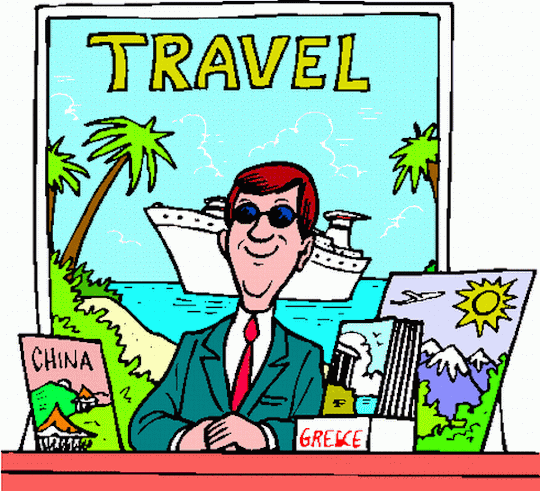
While many independent travellers tend to shun organized tours, they are often hard to avoid. Many destinations (think the Galápagos Islands, a safari, Antarctica, or the Inca Trail) are hard to do without them. Though they are usually identified with big buses, camera-clicking, and Bermuda-shorts-wearing tourists, most tour companies aren’t like that at all. I’ve actually taken many organized…
View On WordPress
0 notes
Text
Is Voluntourism Doing More Harm Than Good?
Is Voluntourism Doing More Harm Than Good?

The industry for combining volunteering with travel (or ‘voluntourism’) is booming. But the sector is controversial, accused of irresponsibly promoting the idea that tourists can make a real difference to development by spending a few weeks of their time at a project. According to the critics, this approach purely serves the needs and aspirations of the volunteer, and can have negative effects on…
View On WordPress
0 notes
Text

There is a trend in travel that has picked up a lot of steam over the last few years. That trend is called Eco-Tourism. As the environment has become more important to people over the last decade – and especially so in the last couple of years – companies around the world are trying to cash in on people’s willingness to spend lots of money in the name of environmental protection. Much of it is “greenwashing” though, or insincere and over-hyped attempts to be viewed as “green”. The travel industry has not been immune to this trend and many companies now tout their environmental credentials in an effort to lure customers and create a positive image.
You have to wonder though, just how environmentally friendly is eco-tourism? Eco-tourism is defined as:
“Connecting conservation, communities, and sustainable travel. This means that those who implement and participate in responsible tourism activities should follow the following eco-tourism principles: minimize impact, build environmental and cultural awareness and respect, provide positive experiences for both visitors and hosts, provide direct financial benefits for conservation, provide financial benefits and empowerment for local people, and raise sensitivity to host countries’ political, environmental, and social climate.”
But how many companies really live up to that? How much of it is really greenwashing? If I had to put a number on it – and I am going to – I’d say at least 70% of it is simply greenwashing. The Marriott or other resorts might talk about their commitment to reducing waste by using recycled toilet paper and low-flow shower heads, but they have huge mega-hotels. The nature of their hotels means they will never be truly environmentally friendly, unless they rebuild the place from scratch. And most of their customers wouldn’t put up with higher prices to help offset the capital costs of upgrading to be eco-friendly. You can offset your carbon emissions with Qantas but, if you really want to reduce your footprint, you wouldn’t fly. And if you look at the most environmentally friendly hotels and tours, they are also the most expensive. Apparently, eco-tourism is just for the rich.

Invading a gorilla’s territory on an eco-tourism holiday
Companies tout how they are going green to save the environment, but they only make incremental changes designed to make us feel good. Few companies make the capital investment to truly change their business model, especially those in the tourism industry. It’s easier to change toilet paper than change how you design your future hotels. I doubt many cruises have 100% grey-water systems.
And the commitment to local cultures? With the exception of a few tour operators, rarely do you see companies trying to help the local communities in any significant way. They operate big tours with underpaid local staff and export lots of money to headquarters instead of keeping it in the local economy. Ask most of the porters on the Inca Trail how they are treated and you won’t find a favorable response. Just because they hire local staff doesn’t mean they are “giving back” to the community to help it grow.

Mountain guides and porters are badly treated worldwide
Eco-tours market themselves as a low impact, environmental, and community friendly way to see the world. See the Amazon or Patagonia without making a big environmental impact. See Antarctica without making an impact. Visit Tibet without making an impact. Tourists come, learn a bit about the local culture, and then leave, content with the knowledge they “helped” the environment. But the reality is that big companies bring you in, make you feel good about yourself, and take all the profit back home.
I see promise and hope in sustainable tourism. To me this is different from eco-tourism. Eco-tourism to me is about not damaging the environment and providing a little education, but sustainable tourism is about living and growing with the environment and the local cultures. You don’t find this with the big companies. They may change their light bulbs and reduce waste, but would you really consider that sustainable?

The Andaman, a Luxury Collection Resort – Langkawi, Malaysia
Sustainable tourism requires new thinking, and you find this mostly with small-scale operators. These operators change their business structure so as to have as minimal an impact on the environment as possible. They buy local goods, use local services, treat their employees well, use few resources, and try hard to help rebuild the environment and educate tourists.
This is a much more promising side to the eco-tourism trend. By participating in local initiatives that better the environment instead of just a feel good, greenwashed tour, you contribute more substantially to protecting the environment. I believe the eco-tourism trend is here to stay and that is for sure a good thing. However, in order for it to have a much greater impact, there needs to be a focus not only on “using less toilet paper” but also on sustainable, local initiatives that help businesses grow with and heal the environment.
And that doesn’t mean spending two weeks helping to build mud huts in Somalia. That kind of “voluntourism” often does more harm than good. But that’s a story for another time…
Is Eco-Tourism Really Eco-Friendly? There is a trend in travel that has picked up a lot of steam over the last few years.
0 notes
Text
The World Heritage Sites of London
The World Heritage Sites of London

One of the most distinguished titles a historic site can have is that of a UNESCO World Heritage Site. Most countries or cities would be lucky to have one of their local destinations honoured as a world heritage site by UNESCO. According to The Telegraph, the UK has just under 30 natural, cultural and mixed heritage centres, and London is home to four of them. This honour is only given to select…
View On WordPress
#1066#airport#ben#big#botanic#Britain#college#england#gardens#gatwick#greenwich#heathrow#heritage#kew#london#maritime#naval#navy#palace#parliament#royal#sites#standsted#telegraph#thames#tower#UNESCO#westminster#world
0 notes
Text
5 breathtaking road trips in England and Wales
5 breathtaking road trips in England and Wales

Five stretches of UK road that make driving fun – and reveal some of the most stunning countryside you’ll ever see. The UK has over 200,000 miles of road ready to explore. And despite the notorious reputation of some of its motorways – yes, we’re looking at you, M25 – many of its roads are surprisingly picturesque. Of course, it helps when you have stunning road trips like the five listed below –…
View On WordPress
#A4069#A686#Abergwesyn Pass#Black Mountain#Brecon Beacons#Bristol#Cheddar#Cheese#Cumbria#Derbyshire#district#england#Europe#Gorge#guide#Haydon Bridge#Llyn Brianne#Northumberland#pass#peak#Penrith#Powys#road trips#Roof of England#snake#Somerset#wales#West Country#Weston-Super-Mare
0 notes
Text
Hong Kong Travel Guide
Hong Kong Travel Guide
Hong Kong is one of the most densely populated places on earth. Composed of three different islands (Hong Kong Island, Kowloon Island, and the New Territories), there are more than enough sights and sensations to soak up during any type of trip you have planned. From traditional street markets and beautiful temples to the fast-moving, skyscraper-dotted streets, and the endless food and drink…
View On WordPress
0 notes
Text
The Top 20 of Filipino Street Foods
The Top 20 of Filipino Street Foods
View On WordPress
#adidas#Asia#babana#balut#betamax#binatog#budget#buko#camote#coron#dirty#drink#fishball#food#helmet#holiday#ice cream#isaw#iskrambol#kikiam#kwekkwek#neck#packing#palawan#pandan#Philippines#reef#street#taho#travel
0 notes